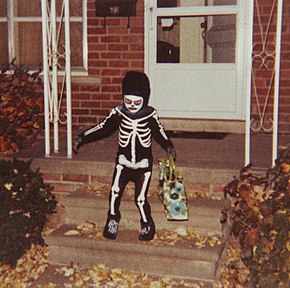
Trick-or-treating is a traditional Halloween custom for children and adults in some countries. During the evening of Halloween, on October 31, people in costumes travel from house to house, asking for treats with the phrase "trick or treat". The "treat" is some form of confectionery, usually candy/sweets, although in some cultures money is given instead. The "trick" refers to a threat, usually idle, to perform mischief on the resident(s) or their property if no treat is given. Some people signal that they are willing to hand out treats by putting up Halloween decorations outside their doors; houses may also leave their porch lights on as a universal indicator that they have candy; some simply leave treats available on their porches for the children to take freely, on the honor system.
The history of trick-or-treating traces back to Scotland and Ireland, where the tradition of guising, going house to house at Halloween and putting on a small performance to be rewarded with food or treats, goes back at least as far as the 16th century, as does the tradition of people wearing costumes at Halloween. There are many accounts from 19th-century Scotland and Ireland of people going house to house in costume at Halloween, reciting verses in exchange for food, and sometimes warning of misfortune if they were not welcomed.[1][2][3] In North America, the earliest known occurrence of guising is from 1898, when children were recorded as having done this in the province of British Columbia, Canada.[4] The interjection "trick or treat!" was then first recorded in the same Canadian province of Ontario in 1917.[5] While going house to house in costume has long been popular among the Scots and Irish, it is only in the 2000s that saying "trick or treat" has become common in Scotland and Ireland.[2] Prior to this, children in Ireland would commonly say "help the Halloween party" at the doors of homeowners.[2]
The activity is prevalent in the Anglospheric countries of the United Kingdom, Ireland, the United States and Canada. It also has extended into Mexico. In northwestern and central Mexico, the practice is called calaverita (Spanish diminutive for calavera, "skull" in English), and instead of "trick or treat", the children ask, "¿Me da mi calaverita?" ("[Can you] give me my little skull?"), where a calaverita is a small skull made of sugar or chocolate.
- ^ Roger, Tricking (2003). Halloween: From Pagan Ritual to Party Night. Oxford University Press. pp. 28–30. ISBN 0-19-514691-3.
- ^ a b c Cite error: The named reference
Irish Timeswas invoked but never defined (see the help page). - ^ "Definition of "guising"". Collins English Dictionary.
(in Scotland and N England) the practice or custom of disguising oneself in fancy dress, often with a mask, and visiting people's houses, esp at Halloween
- ^ "Halloween in Canada". www.thecanadianencyclopedia.ca. Retrieved 2024-11-15.
- ^ Cite error: The named reference
Phrasewas invoked but never defined (see the help page).